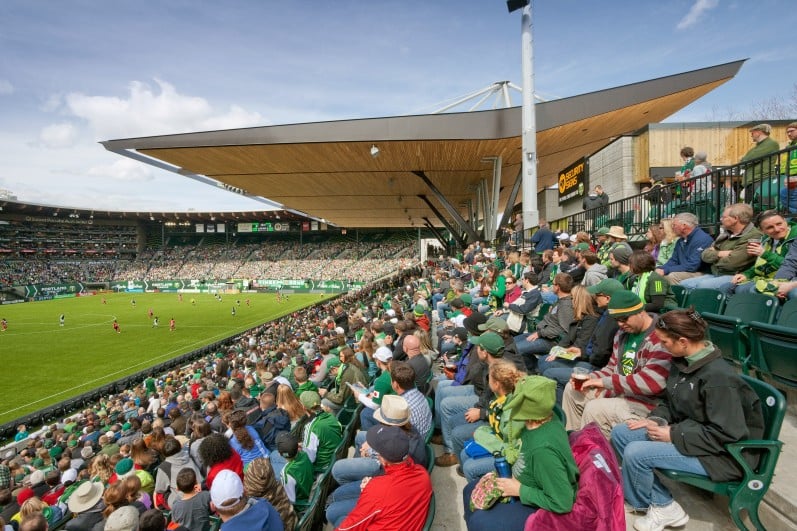For years, the Portland Timbers had been sharing a stadium with the city’s Triple-A baseball team. But when the Timbers were selected to join Major League Soccer (MLS) starting in the 2011 season, the challenge was clear. The club needed a stadium that adhered to MLS standards, with a field configured for soccer, in a stadium with sight lines optimized for the sport.
Less tangible qualities included an atmosphere that would honor the fans and the legacy of soccer in the city of Portland. In 2009, work commenced on a $36-million renovation to configure the stadium for soccer and American football, to be ready in time for the 2011 MLS season.
The charge to the AECOM design team was clear. We needed to convert a 1930s-era multipurpose stadium to a trend-setting MLS venue. Located within the urban core, the stadium needed to retain its deep connections to the community, with a design that uniquely reflected Portland and enhanced the role of the venue within the urban fabric. It needed to provide an atmosphere that channeled the legacy of the Timbers and their loyal followers, the Timbers Army, and translate that into home field advantage.
We needed to create a balance between a contemporary architectural solution and respect for the stadium’s most beloved characteristics. The solution grew out of a desire to provide a design that was regional and resonated with the community.
We looked at the qualities and materials used in the old stadium and extended them into modern construction. The roof structure of the original stadium is constructed of large timbers from the 1930s, which clearly relate to the Pacific Northwest context and the available local resources of forests and evergreens. The poured concrete features a wood grain pattern from the original wooden forms; this was also carried through into the new construction but left unpainted, expressing its natural qualities.
A new dynamic floating steel canopy is clad in cedar and covers most of the new seats in the east section, providing a contemporary interpretation of the existing wood roof structure and paying homage to its Pacific Northwest context.
The renovation elevates the stadium to MLS standards and enhances the fan experience by increasing the functionality of the venue and introducing new amenities. The field configuration was modified and aligned to the north-south axis of the stadium, with 4,000 new fixed seats constructed in what was formerly the outfield of the baseball stadium.
The new seats have industry-leading leg room and width, with a majority of the seats covered by the new cantilevered roof. Approximately 1,144 of the new seats are premium club seats, with the highest level of fan amenities, including a separate entrance with access to the new 5,200-square-foot KeyBank Club and terrace.
The stadium needed to be as intimidating as possible to opposing teams. That was accomplished by moving the field closer to the Timbers Army. The stadium boasts acoustic design strategies that maximize crowd noise, with premium field-level seats as close as 15 feet from the sideline. The proximity to the field and the additional fans make the stadium louder than ever.
That energy will be shared with the city: the stadium features a promenade and an open concourse with public views to the action inside. Other amenities include the new KeyBank Club, view terrace, a community meeting room and three group and family decks. Additional restrooms, concession stands and widened concourses serve the new seating areas.
Providing soccer-specific sight lines was a key design imperative. All spectators in the new stands can see every aspect of the game, without any obstructed views.
Team amenities include upgraded locker rooms, new weight training facilities, office space, a team meeting room, as well as a renovated press box. To meet league requirements and industry standards, new video and broadcast technology was an integral part of the renovation.
To add to Portland’s network of public open space, a public plaza was developed at the corner of 18th Avenue and Morrison Street. This plaza frames the main entrance to the stadium and serves as an accessible public gathering space during non-game hours. Views of the field from this public promenade and an open concourse further enhance the stadium’s relationship to its larger urban context.
Connections to public transit, including a light-rail stop in front of the stadium, further embed the stadium in the urban fabric. The new plazas can play host to community markets and programs while connecting the activity inside the stadium with the rest of the city.
The fan response to the new Providence Park has been overwhelmingly positive. For more than 30 years, the Timbers have been an important part of Oregon’s sports community. Now one of the nation’s elite soccer clubs, their new home at Providence Park is a lasting symbol of the Timbers’ commitment to the city and their loyal fans.
And the Timbers’ fans returned the favor. After the triumphant victory in their inaugural home match, Head Coach John Spencer said on MLS Soccer.com, “I don’t think you’ve seen an atmosphere like that in American soccer history. Ever. I think it was tremendous.”
This project won the AIA San Francisco Chapter’s 2012 Merit Award for Architecture.
Partners
Fletcher, Farr, Ayotte, PC: Associate Architect | Anderson Krygier: Graphic Design | Pelton Marsh Kinsella: Acoustics/Sound Reinforcement | Turner Construction Company: Construction

